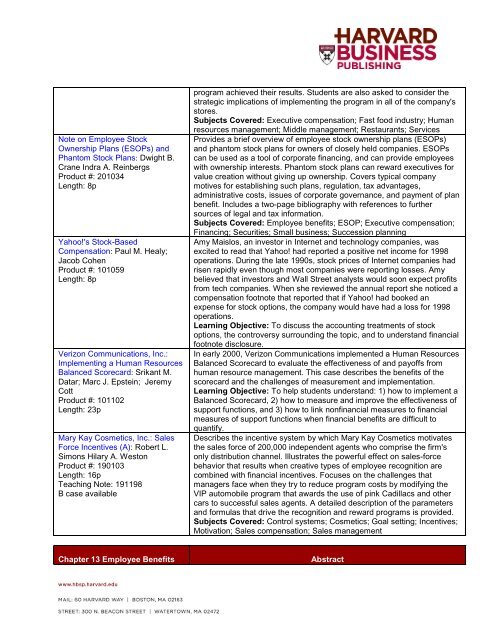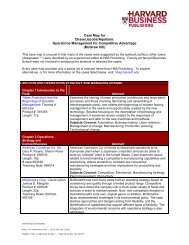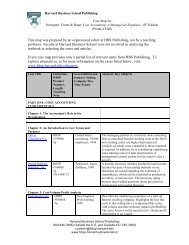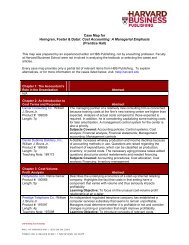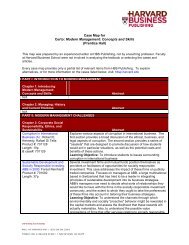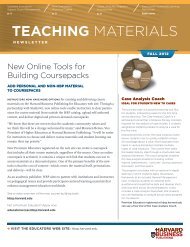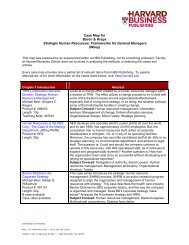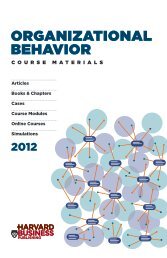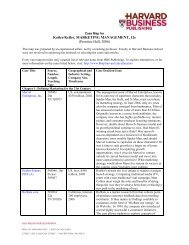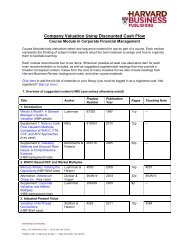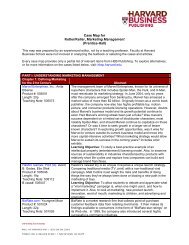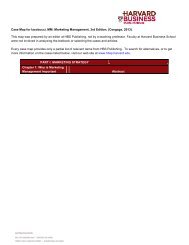Case Map for Noe, Hollenbeck, Gerhart & Wright - Harvard Business ...
Case Map for Noe, Hollenbeck, Gerhart & Wright - Harvard Business ...
Case Map for Noe, Hollenbeck, Gerhart & Wright - Harvard Business ...
Create successful ePaper yourself
Turn your PDF publications into a flip-book with our unique Google optimized e-Paper software.
Note on Employee Stock<br />
Ownership Plans (ESOPs) and<br />
Phantom Stock Plans: Dwight B.<br />
Crane Indra A. Reinbergs<br />
Product #: 201034<br />
Length: 8p<br />
Yahoo!'s Stock-Based<br />
Compensation: Paul M. Healy;<br />
Jacob Cohen<br />
Product #: 101059<br />
Length: 8p<br />
Verizon Communications, Inc.:<br />
Implementing a Human Resources<br />
Balanced Scorecard: Srikant M.<br />
Datar; Marc J. Epstein; Jeremy<br />
Cott<br />
Product #: 101102<br />
Length: 23p<br />
Mary Kay Cosmetics, Inc.: Sales<br />
Force Incentives (A): Robert L.<br />
Simons Hilary A. Weston<br />
Product #: 190103<br />
Length: 16p<br />
Teaching Note: 191198<br />
B case available<br />
Chapter 13 Employee Benefits<br />
program achieved their results. Students are also asked to consider the<br />
strategic implications of implementing the program in all of the company's<br />
stores.<br />
Subjects Covered: Executive compensation; Fast food industry; Human<br />
resources management; Middle management; Restaurants; Services<br />
Provides a brief overview of employee stock ownership plans (ESOPs)<br />
and phantom stock plans <strong>for</strong> owners of closely held companies. ESOPs<br />
can be used as a tool of corporate financing, and can provide employees<br />
with ownership interests. Phantom stock plans can reward executives <strong>for</strong><br />
value creation without giving up ownership. Covers typical company<br />
motives <strong>for</strong> establishing such plans, regulation, tax advantages,<br />
administrative costs, issues of corporate governance, and payment of plan<br />
benefit. Includes a two-page bibliography with references to further<br />
sources of legal and tax in<strong>for</strong>mation.<br />
Subjects Covered: Employee benefits; ESOP; Executive compensation;<br />
Financing; Securities; Small business; Succession planning<br />
Amy Maislos, an investor in Internet and technology companies, was<br />
excited to read that Yahoo! had reported a positive net income <strong>for</strong> 1998<br />
operations. During the late 1990s, stock prices of Internet companies had<br />
risen rapidly even though most companies were reporting losses. Amy<br />
believed that investors and Wall Street analysts would soon expect profits<br />
from tech companies. When she reviewed the annual report she noticed a<br />
compensation footnote that reported that if Yahoo! had booked an<br />
expense <strong>for</strong> stock options, the company would have had a loss <strong>for</strong> 1998<br />
operations.<br />
Learning Objective: To discuss the accounting treatments of stock<br />
options, the controversy surrounding the topic, and to understand financial<br />
footnote disclosure.<br />
In early 2000, Verizon Communications implemented a Human Resources<br />
Balanced Scorecard to evaluate the effectiveness of and payoffs from<br />
human resource management. This case describes the benefits of the<br />
scorecard and the challenges of measurement and implementation.<br />
Learning Objective: To help students understand: 1) how to implement a<br />
Balanced Scorecard, 2) how to measure and improve the effectiveness of<br />
support functions, and 3) how to link nonfinancial measures to financial<br />
measures of support functions when financial benefits are difficult to<br />
quantify.<br />
Describes the incentive system by which Mary Kay Cosmetics motivates<br />
the sales <strong>for</strong>ce of 200,000 independent agents who comprise the firm's<br />
only distribution channel. Illustrates the powerful effect on sales-<strong>for</strong>ce<br />
behavior that results when creative types of employee recognition are<br />
combined with financial incentives. Focuses on the challenges that<br />
managers face when they try to reduce program costs by modifying the<br />
VIP automobile program that awards the use of pink Cadillacs and other<br />
cars to successful sales agents. A detailed description of the parameters<br />
and <strong>for</strong>mulas that drive the recognition and reward programs is provided.<br />
Subjects Covered: Control systems; Cosmetics; Goal setting; Incentives;<br />
Motivation; Sales compensation; Sales management<br />
Abstract


